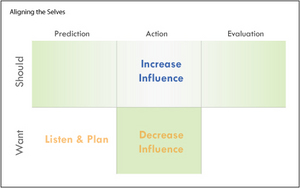A few months ago I came across a presentation titled Organizations in Crisis and Decline, by Randall Dunham. After giving examples of organizations in crisis and decline that include Kmart, General Motors, United Airlines, and Michael Jackson. (interesting example of an enterprise…), Dunham goes on to summarize typical symptoms of crisis, the strategic consequences of decline, and 10 behaviors of unhealthy organizations.
I came across this while doing some research on how the structures and cultures of organizations influence modes of thinking, resilience, and decision making, so this is related to some of my postings on enterprise software. It might be a while before I have the chance to write up all the ideas, so I’ll share Dunham’s material now.
Why is this of note to IAs? Quite a few Information architects (practitioners, not just those with the title…) are actively looking for effective tools and modes of understanding to help frame and manage enterprise problems.
Understanding the signs of decline and crisis in organizations can help information architects and other change agents understand the environmental context of a situation in the critical early stages of setting expectations and roles, and before it’s “too late”, when everyone at the management table has strong opinions they must defend. In other words, before making a leap is into an active project, a planning and budgeting cycle, a strategic vision session, etc.
I see (at least) two very important aspects of a situation that Dunham’s warning signs could help identify; how healthy an organization is, and what latitude for activity and change is available. Building on this, these criteria can help identify situations to avoid or be wary of. Of course, organizations in crisis and decline can present opportunities as well as risks, but sometimes the ship is going down no matter how much you try to patch the holes…
For those without powerpoint, I’m going to present some of the material here as text, with acknowledgment that I’m borrowing directly from Dunham, who himself credits this source: Mische, M.A. (2001). Ten warning signs of strategic Decline. In Strategic Renewal: Becoming a High-Performance Organization (pp. 25-30). Upper Saddle River, NJ: Prentice Hall.
Typical Symptoms of Crisis/Decline
- Lower earnings & revenues
- Increased employee turnover
- Reduced market presence
- Decrease in customer satisfaction & interest
- Increasing costs & high structural costs
Strategic Consequences of Crisis/Decline
- Lower market value
- Inconsistent strategies
- Misalignment of internal strategies & external goals
- Diminished capacity to attract top talent
- Increased vulnerability
10 Behaviors that Signal Decline
- The organization exhibits a lack of understanding the environmental and economic realities confronting it, or is in denial
- The management of the organization is arrogant with regard to its view of the world & assessment of its internal competencies. Ex: Icarus Paradox
- The organization has lost perspective with respect to customers, products, suppliers, and competitors
- Management and employees have an insular focus or preoccupation with internal processes, internal measurements, and politics
- The organization has lost its sense of urgency and lacks an attitude of self-determination
- The organization is relying on historical and poorly conceptualized or inappropriate business strategies and traditional management methods to address new & different challenges
- The organization has the propensity to repeat mistakes and fails to learn from past experiences
- The organization has low or slow innovation practices and is late to market with new products/services
- The organization has a tendency to recycle marginally performing managers
- The organization relies exclusively on internal talent as a source of leadership
Key Factors that Contribute to Decline
- Age of the organization: Older, more established firms may rely on legacy practices
- Size of the organization: Large firms with many vertical levels can have trouble adapting
- Financial success and past performance: Past success can lead to desire to follow same path in hopes of future success
- Ownership and equity structure: Is there accountability at all times to outside agents?
- Environmental influences: External shocks
- Ability to learn and discern patterns: Lack of learning organization culture
- Certainty/uncertainty: Effectiveness of change management
- Leadership: Young & inexperienced without desire to learn
Success Can Drive Crisis
- The same processes that lead to success in an organization can also lead to failure
- This is because success promotes rigidity, resistance to change, and habitual response
- Biggest problem – people learn the ‘right’ way to solve a problem and do that over and over again, even if that way will no longer solve the problem
It’s true these are quite general. Naturally, the art is in knowing how to apply them as criteria, or interperet what you found. As a quick test of accuracy, I’ve used the behaviors and warning signs to retrospectively review several of the organizations I’ve seen from the inside. When those organizations showed several of the behaviors and warning signs at an aggregate level (not necessarily my group, but the whole enterprise) then the strategic consequence dunham mentioned were visible at the same time.
From a practical perspective, a rating scale or some indicators of relative degree would be very useful. In order to gauge whether to stay or go, you need to understand the intensity of the decline or crisis and what action you can take: for example, do you have time to go back to the cabin to save your handwritten screenplay before the ship sinks?
